
Original Link: https://www.anandtech.com/show/2299
ZEROtherm BTF90: Sting like a Butterfly?
by Wesley Fink on August 13, 2007 12:05 AM EST- Posted in
- Cases/Cooling/PSUs
Since the success of Zalman as a cooling company based in Korea, there have been many other Korean companies who have aimed for a slice of the cooling pie. One such company is ZEROtherm, who manufactures in Korea and is basically a marketing division of a company called APACK, which is targeted more at the OEM market.
APACK was established in 1999 by three Engineers from ETRI (Electrics and Telecommunications Research Institute) who had extensive experience in thermal solutions and advanced packaging design (packaging meaning integration of multiple technologies). Based in the city of Daejeon (in the Korean Silicon Valley), APACK is still mainly an Engineering company.
Phase one of APACK's growth was producing OEM solutions for companies like Samsung, Dell, and LG. ZEROtherm is part of phase two, which is direct marketing of APACK thermal solutions. ZEROtherm products today include five CPU coolers and four very unusual VGA coolers.
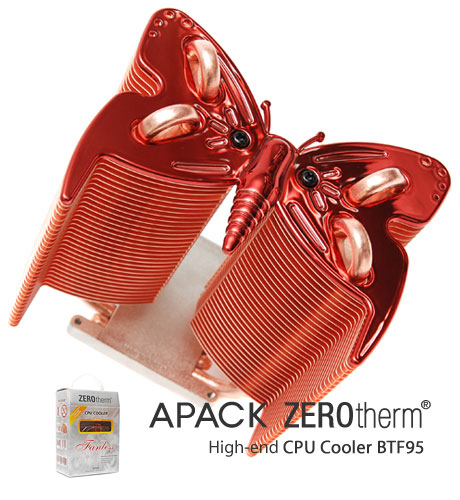
The BTF series currently consists of three coolers that are essentially the same size. All the coolers use fins that are shaped like butterfly wings and ZEROtherm even adds antennae and butterfly bodies to play up the design. The BTF95 is a fanless all copper butterfly, while the BFT90 and BTF80 are the same butterfly in copper and aluminum fin respectively. The 90 and 80 add active cooling with a drop-in Maglev (Magnetic Levitation) fan that ZEROtherm has chosen for silence.
A question for many is which came first - the design or the butterfly. It appears from the info at the ZEROtherm website that the company set out to create a butterfly shape. You would think in an engineering company that performance would have been the first criteria, but it appears ZEROtherm decided to develop a unique butterfly design with cooling performance being a secondary consideration.
The company certainly succeeded in a cooler design that looks like a butterfly, though we confess we cannot figure out the charm of a cooler looking like a butterfly has landed on your CPU. On the other hand, if the butterfly is used to signify silence we can appreciate where this is going, and it is clear in APACK literature that silence was the largest of the performance design goals.
Our test suite heavily emphasizes overclocking performance. While we do measure noise, our test design is based on the premise that if an expensive cooler doesn't outperform the stock Intel retail HSF there is no reason to market the cooler. Beyond the Intel heatsink performance range, those air coolers that cool the highest overclocks do best in our tests. While we report noise levels it is not the main criteria in our testing - it is just additional info to help buyers decide what to get.
We will try to pay a bit more attention to noise in reviewing the Butterfly. Does the BTF90 perform well compared to other top air coolers? Does ZEROtherm reach their goal of relative silence when compared to other coolers? And most important, does the ZEROtherm BTF90 deliver good value considering the price you will pay?
ZEROtherm BTF90
APACK packages the BTF90 in an attractive matte silver windowed package with an unusual slant to the top of the package. The packaging is professional looking and doesn't scream with the garishness we sometimes see in Asian accessories. All the information you need to make a buying decision is on the box - specifications, included accessories, CPU compatibility, etc.

The unique attributes of the cooler are detailed on the package, along with the cooler specifications. Much is said about silence innovations like the 4-pin fan connector to a variable speed magnetic levitation 750-2500 RPM 92mm fan. This fan size is smaller than the more common 120mm fan we are seeing on almost all of the current top-line air coolers. Inside the package is a clear plastic molded clamshell that protects the individual components.
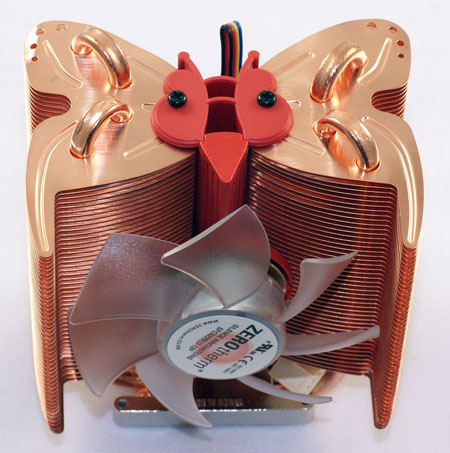
The cooler itself is clearly designed to look like a butterfly. The BTF90 uses a plastic butterfly body and antennae that are part of the fan insert.

The plastic butterfly "body" is actually part of the molded fan clip. The maglev fan is easily removed for mounting the cooler, and access to the mounting screws is much easier with the fan removed. The fan has no guard to protect fingers, but it is somewhat protected by being recessed in the "tails" of the butterfly-wing-shaped cooling fins.
The mirror-polished copper base is protected by a peel-off film. Our sample left residue on the base plate and required cleaning with a solvent to remove the excess glue left behind. Once cleaned it was easy to mount the clip for Intel socket 775.
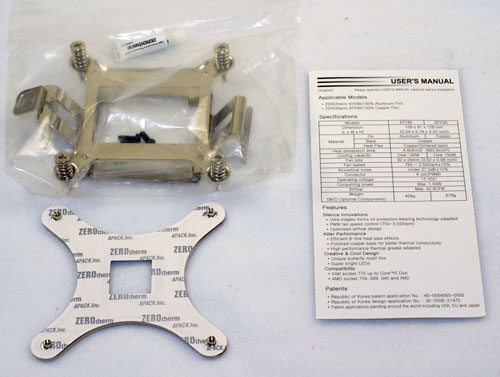
The slanted top holds a box with the accessories and mounting clips inside. Accessories include a mounting base for under the motherboard and a top plate with spring loaded screws for Intel socket 775 and a complete clip for AMD sockets 775/939/940/AM2. There is no cage or backplate for AMD, but the provided clip should fit the existing mounting cage on recent AMD/AM2 motherboards. Mounting of either Intel or AMD processors is very simple. Also included is a small tube of premium thermal paste and installation instructions.

Mounting is simple and very secure with either 775 or AMD. However, you will have to remove the motherboard to install the cooler on Intel 775. While the motherboard is removed, place the base plate through the 4-holes in the 775 motherboard and start the four spring screws. You can finish tightening the spring screws once the board is mounted. When the system is turned on the BTF90 is illuminated by red LEDs behind the fan.
APACK provides sparse installation instructions for both Intel and AMD. If you need more information you can generally find it at the ZEROtherm website. The BTF90 is both smaller and lighter at 678g than most recently tested top-of-the-line air coolers. However, 678g is still heavier than recommended by Intel for mounted coolers, so the secure mounting methods and solid metal backplate are welcome in the mounting kit. The BTF90 was very secure on Intel 775; the rigidity of the mount with AMD/AM2 is dependent on the rigidity of the motherboard cooler mounting system.
The ZEROtherm BTF90 is not readily available in the US, but you can find it for around $45-$50 at a few locations. It is also available at www.newegg.com, which is currently running a $10 rebate which lowers the price to around $35.
Specifications
Our test system is Intel socket 775, but the BTF90 will also mount on any recent AMD socket as well - including 754/939/940 and AM2. The kit includes a mounting clip for AMD processors, but not a backplate or mounting cage. The clip is designed to work with stock motherboard cooler mount systems for AMD/AM2.
| ZEROtherm BTF90 Specifications | |
| Heatsink | |
| Dimensions | 108(W) X 81 (D) X 128(H)mm |
| Weight | 678g |
| Material | Mirror-Polished Copper Base and Copper Fins |
| Heatpipes | Eight (four looped) sintered copper heatpipes |
| Heat Dissipation Area | 4.404 cm2 (682.6 in2) |
| Cooling Capacity | Over 150W |
| Fan | |
| Fan Size | 92x92x25mm (Not interchangeable) |
| Fan Type | Magnetic Levitation |
| Fan Speed | 750-2500 RPM |
| Airflow | Maximum 42.8 CFM |
| Connector | 4-pin (PWM) |
The BTF90 is both smaller and lighter than the 120mm fan air coolers we have recently tested. However, it is unlikely the BTF90 will fit rack mount systems or the smaller HTPC cases that are popular with video enthusiasts. The embedded fan makes reaching the mount screws difficult when installing the BTF90, so it is easiest to remove the fan core before mounting the cooler. You do this by removing the two black screws in the plastic butterfly center on the top of the cooler. It is easy to orient the cooler in any of four directions, which those with unusual case cooling designs will like. We mounted the cooler with the fan blowing through the cooler toward the back of the case.
The EVGA 680i is a difficult to fit board due to the copper-finned heatsink and fan cooling the Northbridge. You would expect the smaller and lighter ZEROtherm BTF90 to be an easier fit than the large coolers we have tested with 120mm fans. This is true in depth, but the added width of the Butterfly tails requires about as much mounting space as a 120mm fan cooler. Still, the BTF90 fit comfortably on the EVGA 680i. Installation was also an easy task on the ASUS Striker and ASUS Commando, and on the two new P35 boards - the ASUS P5K Deluxe and P5K3 Deluxe. The P5K3 Deluxe will likely become a fit test for any motherboard, since the heatpipes completely circle the CPU socket and connect various cooling heatsinks around the CPU socket.
CPU Cooling Test Configuration
The standard test bed for cooling tests is the EVGA NVIDIA 680i SLI motherboard. This is primarily based on the consistent test results on this board and the NVIDIA Monitor temperature measurement utility, which is part of the nTune program.
NVIDIA Monitor has a drop-down pane for temperature measurement which reports CPU, System, and GPU measurement. At this point reviews will concentrate on CPU temperature. In addition to the real-time temperature measurement, NVIDIA Monitor also has a logging feature which can record temperature in a file in standard increments (we selected every 4 seconds). This allows recording of temperatures during testing, which can then be reviewed when the stress tests are completed. There is also the handy reference of speeds and voltages in the top pane to confirm setup.
NVIDIA Monitor was compared to test results from the Intel TAT (Thermal Analysis Tool). Intel TAT CPU portions do function properly on the EVGA 680i motherboard, but the chipset-specific features do not operate as they should. Idle temperatures in TAT were in line with measured idle temps with NVIDIA Monitor. The CPU stress testing with TAT pushing both cores showed TAT stress temps at 80% CPU usage roughly corresponded to temps reported in our real-world gaming benchmark.
Other components in the cooling test bed are generally the same as those used in our motherboard and memory test bed:
| Cooling Performance Test Configuration | |
| Processor | Intel Core 2 Duo X6800 (x2, 2.93GHz, 4MB Unified Cache) |
| RAM | 2x1GB Corsair Dominator PC2-8888 (DDR2-1111) |
| Hard Drive | Hitachi 250GB SATA2 enabled (16MB Buffer) |
| Video Card | 1 x EVGA 7900GTX - All Standard Tests |
| Platform Drivers | NVIDIA 9.53 |
| NVIDIA nTune | 5.05.22.00 (1/16/2007) |
| Video Drivers | NVIDIA 93.71 |
| CPU Cooling | ZEROtherm BTF90 Xigmatek AIO (AIO-S800P) Evercool Silver Knight Enzotech Ultra-X 3RSystem iCEAGE Thermaltake Big Typhoon VX Thermaltake MaxOrb Scythe Andy Samurai Master Cooler Master Gemini II Noctua NH-U12F Asus Silent Square Pro Scythe Ninja Plus Rev. B OCZ Vindicator Thermalright Ultra 120 Extreme Thermalright Ultra 120 Scythe Infinity Zalman CNS9700 Zalman CNS9500 Cooler Master Hyper 6+ Vigor Monsoon II Lite Thermalright MST-9775 Scythe Katana Tuniq Tower 120 Intel Stock HSF for X6800 |
| Power Supply | OCZ PowerStream 520W |
| Motherboards | EVGA nForce 680i SLI (NVIDIA 680i) |
| Operating System | Windows XP Professional SP2 |
| BIOS | Award P26 (1/12/2007) |
All cooling tests are run with the components mounted in a standard mid-tower case. The idle and stress temperature tests are run with the case closed and standing as it would in most home setups. We do not use auxiliary fans in the test cooling case, except for the Northbridge fan attached to the 680i for overclocking. Room temperature is measured before beginning the cooler tests and is maintained in the 20 to 22C (68 to 72F) range for all testing.
APACK provided a small tube of premium thermal grease with the BTF90. However, for consistency of test results we tested with our standard premium silver-colored thermal compound. In our experience the thermal compound used makes little to no difference in cooling test results. This is particularly true now that processors ship with a large manufacturer-installed heatspreader. Our current test procedure uses this standard high-quality silver-colored thermal paste for all cooler reviews.
We test the stock Intel cooler at standard X6800 speed, measuring the CPU temperature at idle and while the CPU is being stressed. The CPU is stressed by running continuous loops of the Far Cry River demo. The same tests are repeated at the highest stable overclock we can achieve with the stock cooler. Stable in this case means the ability to handle our Far Cry looping for at least 30 minutes.
The same benchmarks are then run on the cooler under test at stock, highest stock cooler OC speed (3.73GHz), and the highest OC that can be achieved in the same setup with the cooler being tested. This allows measurement of the cooling efficiency of the test unit compared to stock and the improvement in overclocking capabilities, if any, from using the test cooler.
Noise Levels
In addition to cooling efficiency and overclocking abilities, users shopping for CPU cooling solutions may also be interested in the noise levels of the cooling devices they are considering. Noise levels are measured with the case on its side using a C.E.M. DT-8850 Sound Level meter.
This meter allows accurate sound level measurements from 35bdB to 130dB with a resolution of 0.1dB and an accuracy of 1.5dB. This is sufficient for our needs in these tests, as measurement starts at the level of a relatively quiet room. Our own test room, with all computers and fans turned off, has a room noise level of 36.4dB.
Procedures for measuring cooling system noise are described on page five, which reports measured noise results comparing the stock Intel cooler and recently tested CPU coolers to the ZEROtherm BTF90.
Cooling at Stock Speed
Some users will never overclock their CPU, but they still want to run the coolest CPU temperatures possible to enhance stability and extend CPU life. The ZEROtherm BTF90 uses a 4-pin connector to allow the motherboard to control fan speed. The supplied fan is a standard 92mm size, but it is embedded and not user changeable.
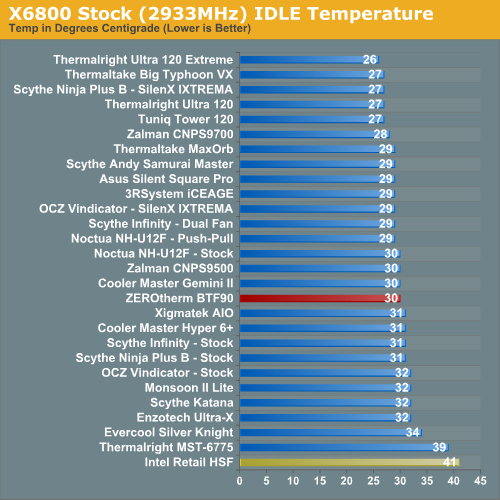
Where the very good Intel stock cooler keeps the X6800 at 41C at idle, the BTF90 manages 30C. This is a significant improvement over the Intel stock cooler performance at 41C, but the results are average among top air coolers tested at AnandTech. The Thermalright coolers, at the top of our heatpipe tower performance charts, cool to 26C and 27C, and the Tuniq 120 maintains 27C. The BTF would likely do better if the fan were run at maximum speed at idle, since the speed is auto controlled by the temperature of the processor. Still, the performance is quite good for a cooler using a 92mm fan running at its slowest speed.
It is more difficult to effectively simulate a computer being stressed by all of the conditions it might be exposed to in different operating environments. For most home users CPU power is most taxed with contemporary gaming. Therefore our stress test simulates playing a demanding game.
The Far Cry River demo is looped for 30 minutes and the CPU temperature is captured at 4 second intervals with the NVIDIA Monitor "logging" option. The highest temperature during the load test is then reported. Momentary spikes are ignored, as we report a sustained high-level temp that you would expect to find in this recording configuration. This test configuration roughly equates to an 80% CPU load test using Intel TAT.
Cooling efficiency of the ZEROtherm BTF90 was then compared under load conditions at stock speed to the retail HSF and other recently tested CPU coolers.
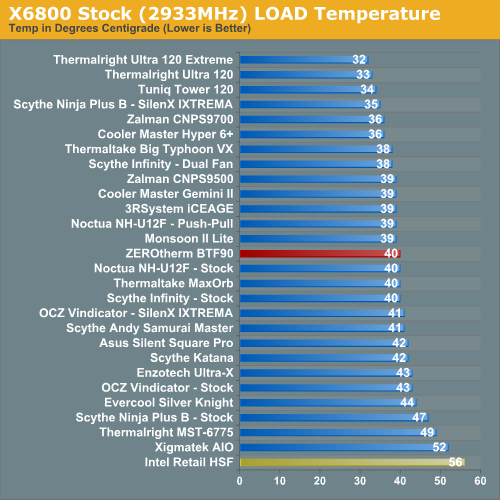
The BTF90 under load at stock speeds reached a maximum temperature of 40C with the included fan at highest auto speed. This compares to the Thermalrights at 32C and 33C, the Tuniq at 34C, and the cooler Master Hyper 6+ and Zalman 9700 at 36C. Stock load performance is average among tested coolers. This is really a very good performance for a cooler using a 92mm fan when you consider that almost every other air cooler tested at AnandTech uses a 120mm fan for cooling.
Noise
For many enthusiasts upgrading cooling the goal is maximum stable overclock, and they will live with the inconvenience of a louder system. For other users silence is the most important factor, and these users will forgo maximum overclocking if that increases system noise levels.
There are very few power supplies that do not have a fan. While Zalman and a few others do make expensive fanless power supplies, we have not seen a fanless unit larger than 500W, or one that would be used for seriously overclocking a system. With that in mind the noise level of the system with all fans turned off except the PSU was measured. The power supply used for the cooling test bed is the OCZ PowerStream 520, which is one of the quieter high performance power supplies.
We have also measured the Corsair 620W and Mushkin 650W power supplies which are reported to be quieter than the OCZ. Both the Corsair and Mushkin are indeed quieter at idle or start up speed. However, as soon as load testing begins and the PSU fan speed kicks up the measured noise level is almost exactly the same as the OCZ PowerStream 520W.
We are currently in the process of reevaluating our cooler test bed and planning some updates. The new configuration will include a "quieter" power supply with variable speed and noise levels. We will also update to a P35 chipset motherboard with all passive cooling to the chipset. Changes to the test bed will appear as part of a future roundup with the motherboard, PSU, and CPU all upgraded to more current configurations. We are also investigating a change to a quad-core processor as a further challenge to CPU cooling.
The noise level of the power supply is 38.3 dB from 24" (61cm) and 47 dB from 6" (152mm). The measured noise level of the test room is 36.4 dB, which is a relatively quiet room with a noise floor slightly below that of the OCZ PowerStream 520 PSU.
Noise levels are measured with the test coolers with fans at both low and high speeds. Both measurements were taken at 6" and 24" above the cooling fan on an open case side. Results are then compared to the other coolers/fans tested in this category. Measured noise levels in this chart should be considered worst case. Measurements are taken with an open side of a mid tower case 6" and 24" from the HSF. Real world would be a completely closed case with a further reduction in noise. Please look for both low and high speed results in the noise graphs.
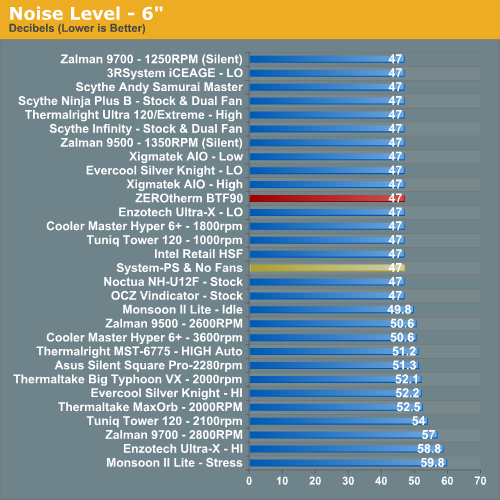
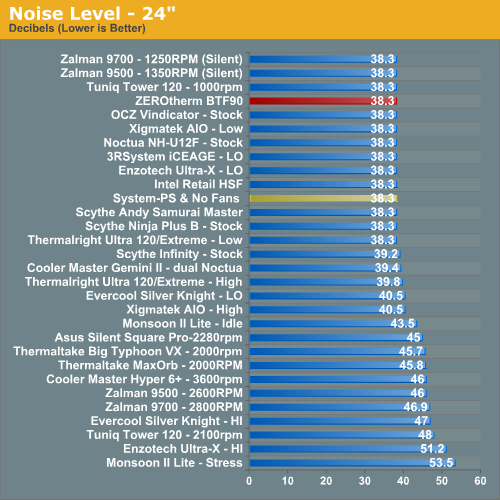
In all cases, under both idle and stress conditions, the BTF90 remains at noise levels below our system noise floor. This is not surprising given the use of a Maglev fan for the BTF90 with a modest maximum output of 42.8 CFM. The quiet operation of the ZEROtherm makes it ideal for use in systems where silence is a main consideration.
Scaling of Cooling Performance
The BTF90 performance was average at both stock idle and stock load compared to other top coolers tested at AnandTech. Keeping in perspective that a 92mm fan drives the BTF90 compared to the 120mm fans used on most other coolers, this performance would have to be considered very good. As overclocks are raised, the ZEROtherm exhibits improved performance in the ability to cool the CPU under stress conditions.
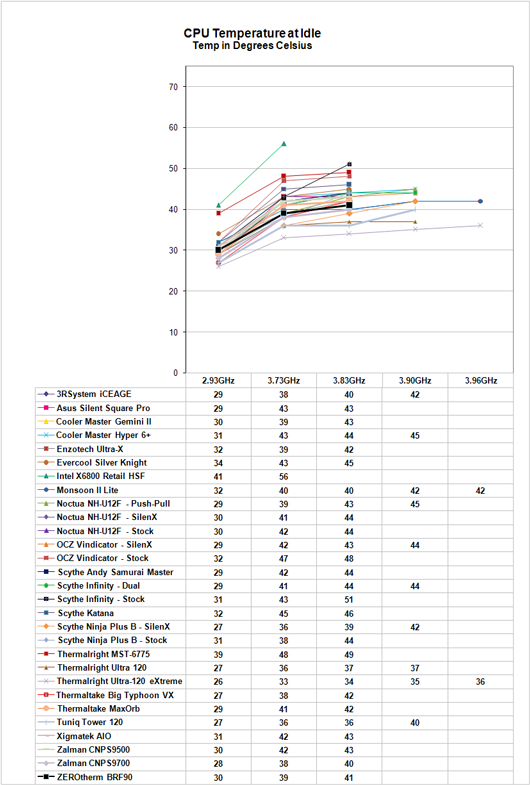 |
| Click to enlarge |
At 2.93GHz the retail HSF is running at 41C, compared to 30C with the BTF90. This is a delta of 11C. The delta becomes greater as the overclock increases. At 3.73GHz the idle with the retail fan is 56C compared to the Ultra-X at 39C - a delta of 17C. The cooling performance of the BTF90 is much better than the Intel retail cooler at idle, but the ZEROtherm does not reach the same cooling levels measured with the Thermalrights (with a Scythe S-Flex SFF21F fan) or the stock Tuniq 120. The top Thermalright Ultra-120 eXtreme, for example, is at 33C at the same 3.73GHz.
We also need to compare cooling efficiency of the ZEROtherm BTF90 under load conditions to the retail HSF and other recently tested CPU coolers. Load testing can be very revealing of a cooler's efficiency. A basically flat line, particularly form 3.73GHz upward, indicates the cooler is still in its best cooling range. A line that is increasing rapidly indicates a cooler nearing the end of its ability to cool efficiently. Lines which parallel the best coolers over a range of values are indicate that the coolers have similar cooling efficiency.
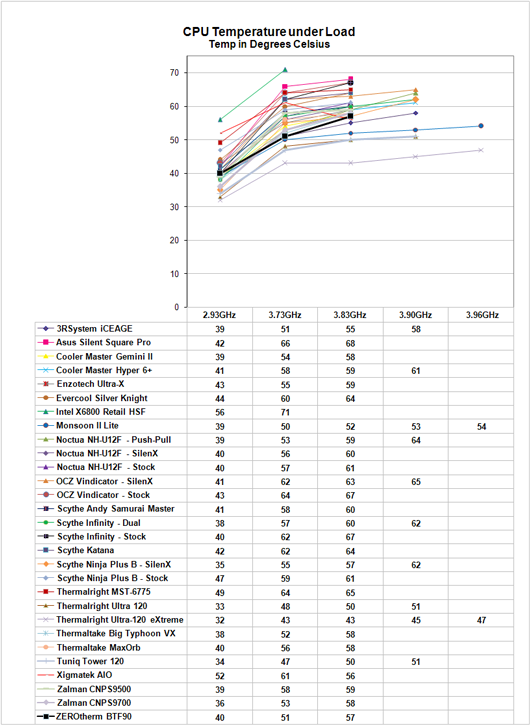 |
| Click to enlarge |
The BTF90 is very efficient in cooling in the 2.93 GHz to 3.73 GHz overclock range. The BTF90 continues on to a highest overclock of 3.83GHz, but the cooling curve is much steeper in this area, suggesting the BTF90 is losing cooling efficiency. The BTF90 falls short of the 3.90GHz to 3.94GHz most of the top coolers in our testing have achieved, but it is also cooling with a smaller fan with a smaller output than the other coolers. It also manages this with relative quiet, as seen in the noise tests.
As stated many times, the overclocking abilities of the CPU will vary at the top, depending on the CPU. This particular CPU does higher FSB speeds than any X6800 we have tested, but the 3.90GHz top speed with the Tuniq is pretty average among the X6800 processors we have tested with Tuniq cooling. A few of the other processors tested with the best air coolers reach just over 4 GHz, but the range has been 3.8 to 4.0GHz. Stock cooling generally tops out 200 to 400 MHz lower, depending on the CPU, on the processors tested in our lab.
Overclocking
As cooling solutions do a better job of keeping the CPU at a lower temperature, it is reasonable to expect the overclocking capabilities of the CPU will increase. In each test of a cooler we measure the highest stable overclock of a standard X6800 processor under the following conditions:
CPU Multiplier: 14x (Stock 11x)
CPU voltage: 1.5875V
FSB Voltage: 1.30V
Memory Voltage: 2.00V
nForce SPP Voltage: 1.35V
nForce MCP Voltage: 1.7V
HT nForce SPP <-> MCP: Auto
Memory is set to Auto timings on the 680i and memory speed is linked to the FSB for the overclocking tests. This removes memory as any kind of impediment to the maximum stable overclock. Linked settings on the 680i are a 1066FSB to a memory speed of DDR2-800. As the FSB is raised the linked memory speed increases in proportion. The same processor is used in all cooling tests to ensure comparable results.
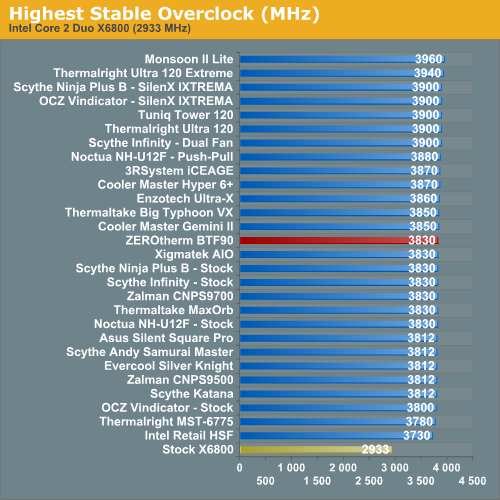
The ZEROtherm BTF90 reached a stable 3.83 GHz, which places it in the middle of the overclocking pack. Again, considering cooling is with a 92mm fan pushing just 42.8 CFM the overclocking must be considered excellent. While the BTF90 could not compete to the 3.90 to 3.94GHz measured with the best heatpipe towers, its performance over the effective range to 3.83GHz is very good.
There is no doubt that the BTF90 is able to dissipate 150W or more of heat. This merely points out the extreme demands that our overclocking cooling tests make of coolers while we push an X6800 processor to its overclock limits. The power requirements of a Core 2 Duo X6800 processor at rated speed and voltage is around 75 watts. At the overclocked speed of 3.830GHz at the commonly required 1.5375V to 1.5625V the wattage has doubled - to 148W to 153W. At the highest air OC with this X6800 of 3.94GHz with a Thermalright Ultra 120 eXtreme wattage has risen to 165W to 168W.
The stock Intel Retail cooler is really an excellent cooler, and the requirement that a tested cooler must perform better than the included Intel cooler is more demanding than you might think. THe Intel stock cooler topped out at 3.73 GHz at just below 1.5V. This means the stock Intel cooler is dissipating 135W at the highest overclock it could reach. These figures should help put in perspective the relative efficiency of the coolers being tested and the extreme conditions of our maximum overclock cooling test bed.
However, a C2D pushed to the incredible overclocks they can reach draws a lot of power, and our cooling test is designed to find where the top coolers fail. Keep this in mind when looking at our cooling results. Many of the middle coolers in our roundup have done very well when tested with AMD processors or with less demanding cooling test procedures.
Conclusion
The ZEROtherm BTF90 is an interesting cooler that does well in our grueling cooler test bed despite the fact that it doesn't top our test charts. It overclocks to 3.83GHz, which places it solidly in the middle of the test results from top air coolers. However, it does this with a smaller 92mm fan that only moves 42.8 CFM, which means the base heatsink is remarkably efficient.
If you look carefully at the cooling scaling charts on page six you will see that the cooling performance of the BTF90 borders on the area of the most efficient Thermalrights and the Tuniq 120. It doesn't beat these superb coolers, but with a smaller, low output fan it does compete well in performance to 3.83GHz. When we also consider the cost is $35 to $45 - much lower than most of the other top coolers - we are forced to conclude that the ZEROtherm is a pretty good cooler for the money.
The lower weight and smaller size will make the BTF90 an easy fit on many boards. The BTF90 mounts securely to socket 775 motherboards with no twisting or tendency to torque when moved. That combined with the lower weight of 678g will be welcomed by those who are fearful of the hanging weight of the bigger coolers in a tower case. The magnetic levitation fan works as promised on the motherboard controlled 4-pin fan connection and it is relatively silent. This makes it a great choice for a quiet PC. The light weight and easy mounting also fit the butterfly image.
When we began this review, we thought the performance of the BTF90 would probably be laughable, but that was certainly not the case. While we are not fans of the cutesy butterfly design, we are left to conclude that the design does work despite being too cute for words. We might even get to like a butterfly in our case.
We would not suggest that the ZEROtherm is the best air cooler we have tested, because it isn't. The Thermalright and Tuniq 120, as well as some push-pull designs, cool better in extreme overclocking than the BTF90. However, the BTF90 does very well to just below the top, with a small, quiet, low-output fan. This fan yields very low noise levels, and the ZEROtherm would be a great choice for a low-noise PC that can still overclock well. However, the BTF90 will not fit slim cases, rack-mount system designs, or under a power supply that mounts above the motherboard. Please check the dimensions carefully if you are planning to use the ZEROtherm in a small HTPC case.
We asked in the title if the BTF90 could "Sting like a Butterfly?" Of course that is a reference to Muhammad Ali's famous "Float like a butterfly, sting like a bee" quote describing how he boxed. We have to conclude that this butterfly carries a pretty good punch, yet the sting is nearly silent - just the way we like it.







